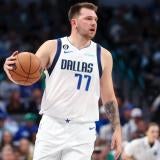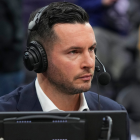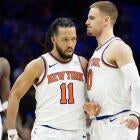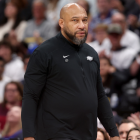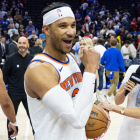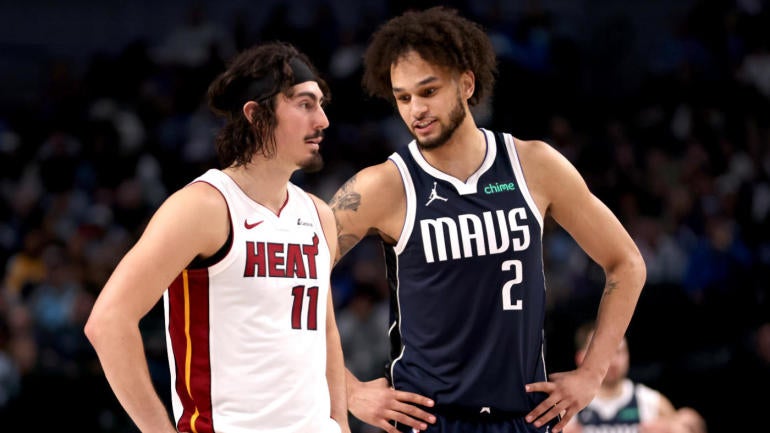
The NBA regular season is over, and that means the vast majority of the NBA's top rookies have finished their first league season in the association. Victor Wembanyama, Brandon Miller, and Chet Holmgren are the three finalists for this year's Rookie of the Year award. Wembanyama and Miller went 1-2 in the 2023 NBA Draft, while Holmgren missed his true rookie season after Oklahoma City selected him second in 2022.
As the rest of the league hits the couch this week and enjoys the first round of the NBA Playoffs, now's a good time to look back at the 2023 draft and redo some selections. If only we knew then what we know now.
1. San Antonio Spurs: C Victor Wembanyama, France
Original pick: Wembanyama
Let's put it plainly… he's every bit as good as advertised. Wembanyama came to the NBA with more hype than arguably any prospect since LeBron James, and a year later, there are no fewer reasons for that level of enthusiasm. Because he's unlike any physical prototype we've ever seen before, there were understandable concerns about whether his body could hold up, but durability was not an issue this year as he played 71 games. Defensively, he led the league in blocks by a wide margin (he averaged 3.6 per game, and Walker Kessler was next at 2.4), and he likely would have gained more traction for Defensive Player of the Year if he played on a more competitive team.
Offensively, the 20-year-old looks every bit capable of being a primary option on a contending team down the road. It wasn't just that he averaged over 21 points in less than 30 minutes per night while shooting 47% from the floor, 33% from 3-point range and 80% from the line, or even that he handed out nearly 4 assists per game. It was the growth he showed during the course of the season. Before Jan. 1, Wemby averaged 18 points, 10 rebounds, 3.3 assists (vs. 3.3 turnovers), and 3.1 blocks on 44/29/79 shooting. After March 1, he averaged 23.7 points, 12 rebounds, 5.4 assists (vs. 4.4 turnovers), and 4.4 blocks on 46/32/75 shooting. Beyond the numbers, this guy was must-see TV because virtually every night, he made some type of logic-defying play that no one else in the league could duplicate because of his massive length and ability to cover the court, coupled with his defensive dominance and offensive escalation. I'm already jacked for Year 2 in the Alamo City.
2. Charlotte Hornets: SF Brandon Miller, Alabama
Original pick: Miller
The Michael Jordan-led front office took a lot of criticism over the years, but let's give credit where credit is due; they (finally?) got their lottery selection right. The choice was between Miller and Scoot Henderson. It was considered a toss-up by most, including Hornets fans, many of whom were unhappy on draft night. A year later, there now appears to have been a clear right answer, and MJ's group made it. Miller averaged 17.3 points, 4.3 rebounds, 2.4 assists, and 1.5 stocks per game with 44/37/83 shooting splits, but he averaged over 20 points per game in the last game of the season after becoming more of an offensive focal point for Charlotte, and thus a key to opposing defensive scouting reports.
There were signs of offensive stardom, with 29 games with 20+ points and 4 games with 30+, in large part because he fused what made him great in high school, the mid-range game, with what defined him at Alabama, his 3-point shooting. This year, he showed the foundation of a true multi-dimensional weapon, with the versatility to make defenses pay for various coverages. His 2.5 made 3-pointers per game were the third-most by a rookie in NBA history while the mid-post and pull-ups that were frowned upon in Nate Oats' system have returned.
Whether Miller blossoms into a true alpha scorer or tops out as a Robin to someone else's Batman remains to be seen. The key variable may be his ability to put pressure on the rim, which was the biggest question mark going into last year's draft. He attempted only about 18% of his total shots at the rim this year, which ranked in the bottom 10% of the league.
3. Portland Trail Blazers: PG Scoot Henderson, G League Ignite
Original pick: Henderson
This is where it gets interesting. On draft night, Portland was perceived to have the easiest pick of the night, other than San Antonio. They would just take whoever Charlotte didn't take. That ended up being Henderson. In retrospect, that looks like a decision that should have considered numerous other options. One year into their NBA career, Wembanyama is at a level all by himself, and Miller actually is too, albeit notably behind Wemby. Who follows depends on if you believe there is another player that has legitimate star upside. That was certainly the belief for Scoot on draft night. Now, it is less clear. While there was plenty of context around his disappointing year -- he had the pressure of replacing arguably the best player in franchise history and was limited by injury at more than one point -- that doesn't account for the discrepancy between what we were expecting and what we saw.
Here's why I still go with him at No. 3. While the probability isn't as high as it was a year ago, there are still all-star caliber outcomes that are possible here, and I'm just not sure there's another player with a higher probability of reaching that level, even if there were others that had better rookie seasons. Henderson showed important progression as a shooter this season, particularly off the dribble, but was surprisingly incapable of finishing at the rim. Given his strength and body type, that's definitely an area he should be able to improve. Finally, patience is a requisite at the point, more so than any other position in the NBA, and given the upside still exists, he's still a worthwhile get at No. 3.
4. Houston Rockets: SF Amen Thompson, Overtime Elite
Original pick: Thompson
There's a lot of different ways Houston could go in a re-draft, but they also have plenty of reasons to feel good about their pick. Thompson not only made significant strides over the course of the season, but he also did it while impacting winning (he had a net rating of +30.1 when on the floor with most of Houston's starting unit. In the first half of the year, he played 17 minutes/night and averaged 7 points, 4.8 boards, and 2.3 assists. In the second half of the season, he played 27.5 and put up 12.1, 8.4, and 2.9. He even punctuated his late gains with a triple-double in the season finale of 18 points, 11 rebounds, 10 assists, three steals and three blocks.
Coming into the draft, Thompson was billed as a potential jumbo lead guard. Ironically, he had the most success this year when utilized as an undersized forward, or even big, in small-ball line-ups. He's every bit the dynamic athlete advertised, and under Ime Udoka, he's weaponizing that to be an ultra-versatile, playmaking defender and elite perimeter rebounder. The offense, in particular the shooting, still needs a lot of work, and the extent to which that develops will ultimately determine his upside, but that's exactly what we expected a year ago. What's changed since then is the floor; he's shown the other ways he can change the game and impact winning.
5. Detroit Pistons: SG Cam Whitmore, Villanova
Original pick: Ausar Thompson
Ausar Thompson was the pick on draft night, and while that's still a reasonable take, in retrospect the Pistons might consider the logic of adding a total non-shooter to a young core that already has shooting concerns. Unless, of course, they believed he had true star potential – which does not yet seem like a practical outcome. I feared it was a bit of a reach and have not yet been proven wrong.
So, what are the other options? Keyonte George might be intriguing here because his on/off-ball versatility and shooting could fit in nicely alongside Cade Cunningham and Jaden Ivey, but the defensive end would be a concern. You could make a similar argument for Brandin Podziemski. The player left on the board though with the highest upside is Whitmore. Ironically, his draft day slide was reportedly rooted out of the intel from Detroit, where GM Troy Weaver's DMV roots were believed to give him access to better intel on Whitmore.
Ultimately, Whitmore slid all the way to 20 and spent a lot of time with Houston's G League affiliate to start the season. Once he cracked the rotation though, he showed the extreme scoring potential many scouts saw last year, albeit with the same limited passing ability. He averaged 12.3 points per game in just 18.7 minutes, equating to 23.7 points and 3.2 made 3-pointers per 36 minutes as a 19-year-old rookie.
6. Orlando Magic: SG Brandin Podziemski, Santa Clara
Original pick: Anthony Black
The Magic went with Black on draft night, and while this doesn't look like the ideal choice in retrospect, I'm not convinced it doesn't work out long-term, especially if Black can sustain this year's shooting numbers. If they were to redo the pick today, knowing what we know now, Podz might get a longer look given his rare ability to impact winning as just a 21-year-old rookie. He led the Warriors in plus-minus this season (and was second among all rookies) while averaging nine points, nearly six rebounds, and four assists (with a better than 3:1 assist-to-turnover ratio). He also led the league in charges drawn with 38. There would be questions about his upside this year, but Black's combination of skill, feel, and sheer intellect for the game made him one of the most underrated prospects in last year's draft.
7. Washington Wizards: C Dereck Lively, Duke
Original pick: Bilal Coulibaly
French star Coulibaly was a home-run type swing on a young and ascending, albeit very unproven, prospect. It was considered a surprise on draft night and a year later, it looks like this might have been a little high for Coulibaly. In contrast, Lively would have given the Wizards arguably the best center in the draft not named Wemby. He plays a role that has proven to be translatable from day one as a shot blocker, lob threat, and rim protector. Lively may not have much star potential, but he could have been a long-term building block for a Wizards team that won only 15 games this year and has only a select few players they should be interested in retaining.
8. Indiana Pacers: PF GG Jackson, South Carolina
Original pick: Jarace Walker
With the four-spot being the gaping hole in both the Pacers' rotation and long-term depth chart, they went with Walker on draft night, albeit after making the heady move to move down a spot and pick up a future asset. Given the maturation he's shown this year, Jackson would be in the mix here if we were to do it all over again, as he's exceeded all expectations in Memphis since joining the team as a second-round pick with an unguaranteed deal. He averaged nearly 15 points per game, made 36% of his 3-pointers, had 12 games with 20-plus points, and four with 30-plus. Most importantly, his energy level and overall approach seem to be vastly different than they were at South Carolina.
9. Utah Jazz: SG Keyonte George, Baylor
Original pick: Taylor Hendricks
Hendricks was the pick here on draft night, while the Jazz were able to find extreme value seven picks later by grabbing George at No. 16. In retrospect, George wouldn't be on the board here, and there's a chance he could be scooped up before now. He's a very clear part of the future in Utah after averaging nearly 16 points and five assists in the last 25 games of the season. He finished fifth among all rookies in scoring and second in assists per game, all of which happened before his 20th birthday. His defense… well, that's another story, but suffice it to say it's a work in progress.
10. Oklahoma City Thunder: PG Cason Wallace, Kentucky
Original pick: Wallace
I think the Thunder got this one right, even if Jaime Jaquez was still on the board (and Ausar Thompson, too, in this scenario). Wallace was an NBA-ready two-way guard and a better shooter than advertised. He knocked down 42% of his 3-pointers and came up with the game-winning stop in Game 1 of the NBA Playoff against the Pelicans. He is consistent and mature beyond his years with extreme durability – he was one of just 17 players in the league to play all 82 games this year. At worst, he projects as an elite two-way role player for a long time, but the most likely outcome is a starting guard with on/off-ball versatility.
11. Magic: PG Anthony Black, Arkansas
Original pick: Jett Howard
As I said above, I still have hope for Black in Orlando. He's the type of defender they value, he can play -- and defend -- multiple positions, he has a high basketball IQ and the potential to be a big initiator or lead guard. His shooting was the major question mark going into last year's draft, but he converted 39% from 3-point range this season, albeit in limited supply. While he is admittedly not in the postseason rotation right now, I think there are enough reasons for Orlando to want to double down on this investment, especially when they have a sure thing like Podz already on the board in this scenario.
12. Dallas Mavericks: SF Jaime Jaquez Jr., UCLA
Original pick: Dereck Lively
Lively was a terrific pick in this spot last year, and Dallas would do that again every day of the week. But Lively is off the board in his redraft, so the Mavs are in a pickle. The player who Jaquez has proven to be is too good to slide any further. The fit is nowhere near as good with the Mavs as with the Heat, but based on everything we have seen at both UCLA and now with the Heat, Jaquez would have figured out how to get on the floor and help impact winning.
13. Toronto Raptors: SF Ausar Thompson, Overtime Elite
Original pick: Gradey Dick
This pick was about taking the best shooter on the board. The Raptors took Dick over Jordan Hawkins. While that is certainly debatable, what is interesting about the Raptors now is that they suddenly find themselves without the long and athletic multi-positional wing types that they seemed to prioritize for so many years. Ausar Thompson is one such wing, and so while the shooting would have undoubtedly been a concern on a team that already lacks great spacing, he would make sense given Toronto's track record and current roster construction following midseason trades of Pascal Siakam and OG Anunoby.
14. Pelicans: SG Jordan Hawkins, UConn
Original pick: Hawkins
Like the Raptors, the Pelicans were looking for shooting. Whether Gradey Dick was still on the board or not, Hawkins still makes a lot of sense. While his production has been very up and down, as too has his overall opportunity, there's no question he has the shooting potential to become a mainstay in the rotation.
Out of the lottery: Bilal Coulibaly, Jarace Walker, Taylor Hendricks, Jett Howard, Gradey Dick










